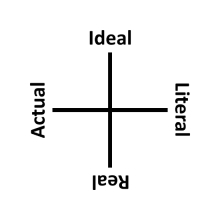 At the beginning of the second book of his “Posterior Analytics”, Aristotle claims that there are four questions for investigating the nature of things and their properties. The answers to these questions hopefully gives us “demonstrable” knowledge about them, or knowledge of a “scientific” nature.
At the beginning of the second book of his “Posterior Analytics”, Aristotle claims that there are four questions for investigating the nature of things and their properties. The answers to these questions hopefully gives us “demonstrable” knowledge about them, or knowledge of a “scientific” nature.
- That it is (to hoti) : Is it a fact that a thing has a property? (Is this that?) “the question of fact” knowing-that

- Why it is (to dioti) : Why does a thing have a property? (Why is this that?) “the question of reason or cause” knowing-why
- Whether it is (ei esti) : Does a thing or property exist? (Does this or that exist?) “the question of if it is or of existence” knowing-if
- What it is (ti esti) : What is the nature and meaning of a thing or property? (What is this or that?) “the question of what it is or of being or essence” knowing-what
 The original terms were innovative in their ancient Greek, and even today cause some confusion in their translation and explanation (at least for this reader, so pardon the multiplicity of phrasings). It seems these questions are more about kinds or universals and not individuals or particulars, so they aren’t really about agents or locations or times (such as who, where, when).
The original terms were innovative in their ancient Greek, and even today cause some confusion in their translation and explanation (at least for this reader, so pardon the multiplicity of phrasings). It seems these questions are more about kinds or universals and not individuals or particulars, so they aren’t really about agents or locations or times (such as who, where, when).
The questions naturally fall into two sets of pairs: the first pair being between a thing and a property (binary), with the first question leading to the second question (knowing the fact comes before knowing the reason for the fact), and the second pair being just about a thing (unary), again with the first question leading to the second question (knowing the existence comes before knowing the essence).
In order to obtain a demonstration that an answer to one of the two questions to hoti or to dioti is correct, Aristotle reasoned that a “middle thing” is needed, a “link” between question and answer. Four types of cause are given, two of which borrowed from his Four Causes (Efficient and Final), and two others (those of definition and of “an antecedent that necessitates a consequent” (does this mean logical entailment or consequence?)).
Robert Sokolowski in the article cited below calls the ei esti and ti esti questions hermeneutic in comparison with the scientific questions to hoti and to dioti, and argues that each pair of questions reciprocally compliment the other, rather than one pair being dependent on the other. That is because the existence and the essence of things being sought after are indeed the “links” being sought after in the how and the why questions.
Obviously these concepts are too deep to be understood at a simplistic level, which is all I have managed so far.
Further Reading:
https://en.wikipedia.org/wiki/Posterior_Analytics
Click to access McK-Hellenistic&RomanFdnsOfAristotleInWest.pdf
Robert Sokolowski / Scientific and Hermeneutic Questions in Aristotle, Philosophy & Rhetoric, Vol. 4, No. 4 (1971), pp. 242-261
https://www.jstor.org/stable/40236788
Patrick Hugh Byrne / Analysis and Science in Aristotle
Keith Bemer / A PHILOSOPHICAL EXAMINATION OF ARISTOTLE’S HISTORIA ANIMALIUM, Thesis 2014, University of Pittsburgh
http://d-scholarship.pitt.edu/22674/
[*11.142, *11.144, *11.146, *11.163]
<>






